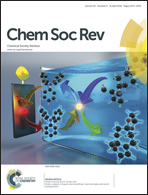Graphdiyne and graphyne: from theoretical predictions to practical construction
Abstract
Flat carbon (sp2 and sp) networks endow the graphdiyne and graphyne families with high degrees of π-conjunction, uniformly distributed pores, and tunable electronic properties; therefore, these materials are attracting much attention from structural, theoretical, and synthetic scientists wishing to take advantage of their promising electronic, optical, and mechanical properties. In this Review, we summarize a state-of-the-art research into graphdiynes and graphynes, with a focus on the latest theoretical and experimental results. In addition to the many theoretical predictions of the potential properties of graphdiynes and graphynes, we also discuss experimental attempts to synthesize and apply graphdiynes in the areas of electronics, photovoltaics, and catalysis.


 Please wait while we load your content...
Please wait while we load your content...